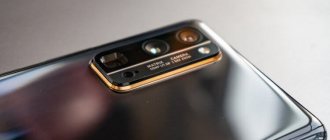Not even a year has passed since the first smartphones with 48 MP cameras appeared on the market, and today large manufacturing companies are already teasing us with all their might with announcements of their upcoming devices with 64 MP cameras. I honestly just can’t wrap my head around how much we have stepped forward in such a short period of time in the direction of mobile photography.
How cameras in smartphones developed in 2022 - main trends
Megapixel race
- At the beginning of 2022, first Redmi Note 7 appeared with a 48 MP Samsung ISOCELL Bright S5KGM1 camera, then came devices with a 48 MP Sony sensor (IMX586 sensor), then Samsung released a 64 MP sensor (Bright GW1), then Sony rolled out the IMX686 64 MP, and Samsung also introduced a 108 MP image sensor, which is now working in Xiaomi Mi Note 10. But that’s not all, at the CES 2022 event, Omnivision presented its 48 MP sensor (OV48C) - we recommend reading about it in this article . After all, this sensor is superior to everything that Sony and Samsung have managed to roll out at the moment.
The absurdity of using 48 MP cameras
- Cameras with a resolution of 40 MP (used in Huawei smartphones) and higher are not needed - these are all marketing tricks. Despite the fact that most of the latest gadgets are increasingly equipped with sensors with a resolution of 48 MP and higher, by default they all shoot at a resolution of 12 MP (16 MP for a 64 MP sensor and 27 MP for a 108 MP). This is because taking photographs in full resolution without combining 4-in-1 pixels is only possible with manual settings, which 99 percent of users do not do. And the very combination of 4-in-1 pixels did not give rise to a revolution, a miracle did not happen. Alas, when comparing the photo quality with the standard 12 MP cameras found in the flagships Pixel 3, Samsung S10, iPhone 11, the latter can produce even better results. Because the essence is not in the MP, but in the software and lenses, and matrices are in last place in this chain.
Three or more photomodules
- The iPhone 7 Plus in 2016 set the multi-camera trend. At first, Android manufacturers actively tried to repeat the success of the Apple gadget, and then went on the offensive. So, the standard + telephoto combination was replaced by the standard + depth sensor + wide-angle + telephoto combination. In the end, Chinese vendors generally went crazy and began to bully us in the form of macro cameras that focus at a distance of 1.5 to 10 cm - a stillborn technology that is still relevant among manufacturers. There is nothing wrong with this, but the implementation of all this is at a deplorable level, especially in the segment of budget smartphones. The quality also suffers greatly on wide-angle cameras and when shooting with background blur.
Having multiple cameras where they are not needed
- We noticed that there are no smartphones that do not focus on cameras. But not all users are mobile photographers - most people want to have a good camera in their smartphone, but nothing more. But in the end, those who just need a good smartphone or gaming machine, gadget for viewing multimedia, etc. they have to overpay for 2, 3, or even 4 cameras they don’t need. That is, manufacturers simply do not give freedom of choice: either pay for everything or have nothing.
realme 7 Pro
- screen 6.4″ (2400×1080 pixels)
- four cameras 64 MP/8 MP/2 MP/2 MP
- memory 8/128 GB, memory card slot
- Qualcomm Snapdragon 720G
- battery 4500 mAh
realme was one of the first to introduce a smartphone with a 64-megapixel camera in Russia - it was realme XT, which is no longer on sale. But there are other worthy devices - for example, the recent realme 7 Pro. The smartphone is equipped with a 6.4-inch Super AMOLED screen with Full HD+ resolution. There is support for HDR10+, which is actually rare in this class.
realme 7 Pro is the record holder for charging speed among all participants in this collection. The 4500 mAh battery is fully charged in just 35 minutes - however, for this you need to use the 65-watt device included in the kit. Other characteristics are also impressive: 8 GB of RAM, 128 permanent memory, triple slot for 2 SIM cards and a memory card. The processor and camera set are typical for this class.
Of course, the device is not cheap - 24,000 rubles. But if a 64-megapixel camera is important to you, you can take the 6 Pro model and save about 5,000 rubles.
What's wrong with 48, 64 and 108 MP sensors
In fact, the desire of manufacturers to make mobile photography better is commendable. And the idea of using a large number of megapixels also has the right to life. Even everything was implemented at approximately a decent level, but what is the problem then? Why don't we get 4 times higher photo quality compared to 12 MP, 16 MP and 27 MP cameras? The answer to this question is not that simple, but there is nothing complicated there. Software, lenses (especially lenses), and the structure of 48, 64 and 108 MP matrices play a role here. We will talk about this in more detail in an express review of each of the sensors, but the most important villains in this whole story are marketers. They say that you will get 4 times better picture quality based solely on the resolution of the sensors, forgetting about the software, the quality of the lenses, and the structure of the sensors. It is they who mislead users, and since the majority do not delve into the features of mobile photo modules, they have no choice but to believe beautiful fairy tales. Of course, over time, people will become more savvy in these matters, but then marketers will tell us completely different tales.
Samsung S5KGM1 48 MP sensor
- Characteristics: resolution 8000x6000 pixels, sensor size 1/2″, physical matrix size 6.4x4.8 mm, pixel size 0.8 microns (1.6 microns when combined 4-in-1 = 12 MP), max ISO 9600 , shooting 4K video @30fps or 1080p up to 240 fps.
The first sensor on which manufacturers, marketers, and eventually smartphone sellers began to speculate. This sensor debuted in the Redmi Note 7 at the beginning of 2022. Then Xiaomi representatives assured that by increasing the number of pixels by 4 times, users would get an almost 4 times better picture: higher detail, dynamic range, better light sensitivity, etc.
But despite the fact that the Samsung S5KGM1 sensor offers 48 MP, by default Redmi Note 7 and others shoot in 12 MP resolution. You can squeeze out one fifty million pixels only when using manual Pro settings in the Camera application. And why? Why haven’t the photographs become 4 times better, why all this pixel combining, where is the deception?
And the answer to this question is this: the Samsung S5KGM1 uses a Quad Bayer filter, which covers 4 subpixels of the sensor with one color cell. Therefore, even when shooting at 48 MP, you do not get full resolution, since a 48 MP monochrome image only has a 12 MP color image. As a result, when combining these two images, there can be no question of any purebred 48 MP - miracles do not happen. That is why, in standard mode, smartphones shoot in 12 MP resolution, while having a solid pixel size of 1.6 microns on each side, which makes it possible to reduce noise and increase light sensitivity in the dark. That is, the idea is good and it works, even if not as it should ideally. But the problem is that everyone is speculating and parasitizing on 48 MP resolution and focusing users’ attention on this aspect.
Second: lens quality. Many of you may say that when shooting in B&W mode, the color filter should not be taken into account and we can get something similar to 48 MP. Yes, there is logic in this, but do not forget that the resolution of the image also depends on the resolution of the lenses in the photomodules. To be clear, to provide a full 48 MP, the smartphone lens must have a lens resolution of 625 line pairs per mm, which is simply impossible in the budget and mid-range segments - too expensive. It’s not a fact that such advanced lenses are also available in flagship models. After all, the dimensions of the lenses in photomodules are tiny and providing them with the proper resolution is not a cheap matter. This again leads to the advisability of combining 4 pixels into 1, and then what 48 MP can we talk about? What kind of 4-fold increase in image quality do manufacturers, marketers and other interested parties even have the right to tell us? Just lies and manipulation.
Sony IMX586 Exmor RS 48 MP sensor
- Characteristics: resolution 8000x6000 pixels, sensor size 1/2″, physical matrix size 6.4x4.8 mm, pixel size 0.8 microns (1.6 microns when combined 4-in-1 = 12 MP), max ISO 9600 , shooting 4K video @90fps or 1080p up to 240 fps.
The 48 MP matrix from Sony is in many ways an analogue of the Samsung sensor, but there are also features that do not allow us to say that they are the same thing. Therefore, in order not to repeat ourselves, let’s immediately move on to the differences: the Sony IMX586 Exmor RS sensor is equipped with a hardware color filter descrambling function. What is the essence of technology? If Samsung GM1 has a Bayer color filter that covers 4 cells with one color at once, then Sony can restore the signal, which allows each pixel to have its own color filter. Hence, the Sony IMX586 Exmor RS can offer an honest 48 MP in color images... However, this is all beautiful only on paper, but in practice again there is no detail that is 4 times improved and again this interpolation is felt, which should not exist at all. This means that the fault here is more with the smartphone manufacturers who skimp on expensive lenses. Otherwise, there is no other way: who will buy an expensive smartphone, the entire cost of which lies only in its camera? No, it’s easier to save on lenses, write 48 MP from Sony on the body of a smartphone and swim in money. And users both received soapy photos and continue to receive them, although they pay for all these imaginary pixels with the memory on their smartphone - the weight of the photo has increased, especially when shooting in full resolution.
In general, the Sony IMX586 Exmor RS is better than its Samsung counterpart, but there is not much difference between them, especially for a sophisticated user. And in general, it becomes clear that it is better to buy an older flagship, but with an honest 12 - 16 MP, which has more or less neat lenses, more advanced software, and no tricks with pixels.
Samsung S5KGM2 48 MP sensor
This is still the same S5KGM1 sensor, only, as in the case of Sony’s IMX586, the technology for descrambling color cells and the ability to produce full 48 MP have appeared. And although the photo quality has improved compared to GM1, there is still no talk of any revolution or even superiority over IMX586.
Samsung S5KGW1 64 MP sensor
- Characteristics: resolution 9280x6944 pixels, sensor size 1/1.72″, pixel size 0.8 microns (1.6 microns when combined 4-in-1 = 16 MP), max ISO 9600, video recording 4K @60fps or 1080p up to 240 fps.
To be honest, there is no point in talking about this sensor. This is because it is built using the same technology as the Sony IMX586 or S5KGM2, only the matrix area has increased. Still the same pixel size, the same technology of descrambling, combining cells, but this time at the output we have up to 64 MP in full resolution and up to 16 MP in 4-in-1 mode. The only thing worth noting is the presence of ISOCELL Plus technology, when the light falling on the matrix cells (pixels) not only does not intersect with light from other cells, but is also reflected from the partitions between the pixels. This allows us to ultimately reduce the number of artifacts and noise as much as possible - the signal is clean and the pixels absorb as many photons of light as possible.
At the same time, the sensor has not lost all the problems that are observed with 48 MP image sensors. The soapiness of the picture has not disappeared anywhere, and an increase in quality, not just 4 times, even 1.5-2 times, is not observed.
Sony IMX686 64 MP sensor
- Characteristics: resolution 9248x6944 pixels, sensor size 1/1.7″ (9.3 mm diagonally), pixel size 0.8 microns (1.6 microns when combined 4-in-1 = 16 MP), max ISO 9600, 4K video shooting @60fps or 1080p up to 240 fps.
In November 2022, Sony, realizing that 48 MP sensors were being snapped up like hot cakes, and looking back at its competitor Samsung, released a similar 64 MP image sensor. But there’s nothing to talk about it - it’s still the same 48 MP IMX586, which was increased in size and pixels were added to the resulting area. That's all the magic.
108 MP Samsung ISOCELL Bright HMX sensor
- Characteristics: resolution 12032x9024 pixels, sensor size 1/1.33″, pixel size 0.8 microns (1.6 microns when combined 4-in-1 = 27 MP), max ISO 9600, video shooting 6K @ 30 fps, 4K @ 60fps or 1080p up to 148 fps.
64 MP was not enough for Samsung and it went further - it introduced a 108 MP image sensor. However, this time the company didn’t bother to change anything in the sensor: the area increased, more pixels were added - done! The only advantage of this sensor is that it allows you to zoom in closer to the image without using a telephoto lens due to digital zoom and with virtually no loss of quality. The picture is simply cropped from 108 MP to 12 MP, leaving the central part and cropping the edges. This is the only advantage of the sensor compared to 48 MP and 64 MP sensors. At the same time, the same problems of picture blur remained, plus there was an added problem with the size of the files, which began to weigh several tens of MB.
Samsung Galaxy S20
- Display: 6.2 inches, AMOLED, 3200*1440
- Processor: Exynos 990
- Memory (RAM/ROM): 8/128 GB
- Camera (main/front): 64+12+12 MP/10 MP
- Battery: 4000 mAh
Price: from 54,700 rub.
Galaxy S20 is the junior smartphone in Samsung's 2020 flagship lineup. Despite this fact, the model is traditionally a strong and interesting device. It has an excellent camera with 30x hybrid zoom, optical stabilization, cool night photography and other features.
In addition, Samsung has, if not the best, then close to it, a display with an under-screen fingerprint sensor, a hole for the camera and a frequency of 120 Hz. The device is powerful, it has a full set of wireless interfaces, it has IP68 moisture protection, any type of charging - reverse, fast, wireless. All this is packaged in a stylish case. There are no significant disadvantages - a combined connector (but there is still support for microSD) and the absence of a headphone jack.
Advantages:
- Performance.
- Autonomy.
- High quality screen.
- Premium appearance.
- Cool camera.
- Moisture protection.
- Stereo speakers.
- 5G support.
Flaws:
- There is no headset jack.
- MicroSD is installed instead of one of the SIM cards.
Poco X3 NFC
The “Poco spirit”, which implies offering advanced characteristics for a very modest price, is felt in full force in this model. The smartphone's arsenal includes a “set” of a huge 6.7-inch display with a refresh rate of 120 Hz (even higher than that of realme and Infinix!), a 5160 mAh battery with 33-watt fast charging, stereo speakers, and a more than decent Qualcomm processor Snapdragon 732G and 6 GB RAM.
In general, it is very difficult to compete with Poco X3 NFC. Although, of course, no one canceled the plastic case, the combined card slot and a couple of other “specks”. Although, to be honest, they are hardly capable of spoiling the overall positive impression of the device.
Infinix Zero 8
This device can be called a seriously upgraded version of the previous one. For example, there are again two front cameras, but the resolution of the main module has increased from 16 to 48 megapixels, the MediaTek Helio G80 chipset has changed to Helio G90T, and the screen resolution has increased to Full HD, plus the frequency has increased from the base 60 Hz to 90 (although the diagonal is slightly decreased: from 6.95 inches to a still decent 6.85). Well, the battery has also become less capacious - 4500 mAh. Although fast charging has accelerated, and the battery is now saturated in 33-watt mode.
In short, this is a Chinese monster with a bunch of chips that they are ready to sell on AliExpress for less than 15 thousand. Well, with NFC everything is exactly the same as with the Infinix Note 8. That is, there is no corresponding chip, and this smartphone will not please its owner with contactless payments.
Infinix Zero 8
What prospects may pixel binning technology have?
Schematic representation of the different principles of constructing a camera matrix and its future in a combination of approaches
First, it’s time to come to terms with the fact that camera resolution has long turned into a conventional indicator that says absolutely nothing about the quality of shooting. Manufacturers of matrixes change the principle of their operation in order to get the maximum possible out of their small size. In the future, we can predict the combination of the two approaches. In addition to the increase in the number of defective dots with the possibility of pixel binning, the technology of using more photodiodes will also be added. Against the backdrop of increasing productivity of gadgets, this can give an interesting result.











